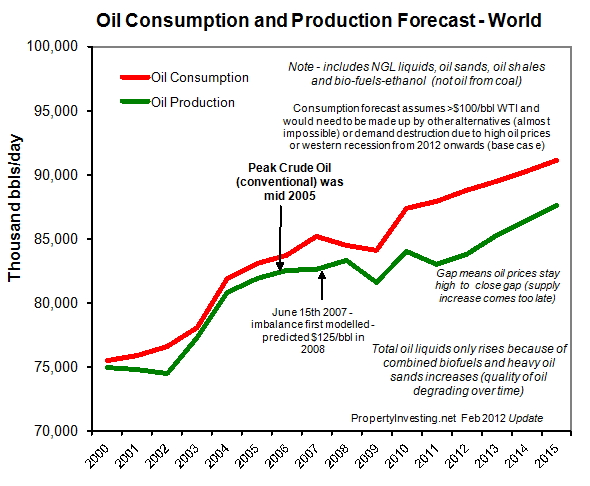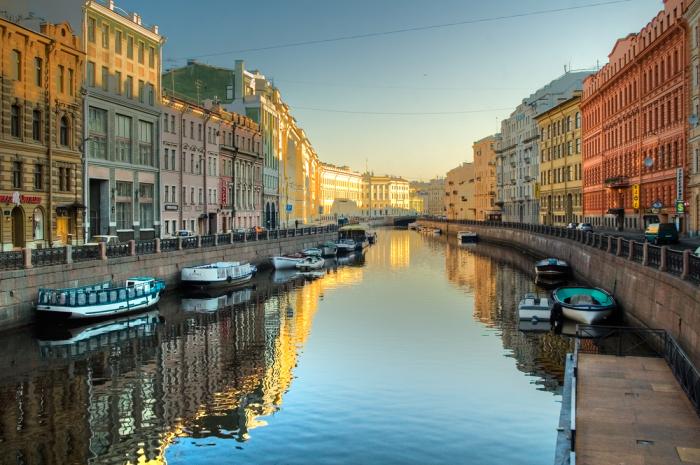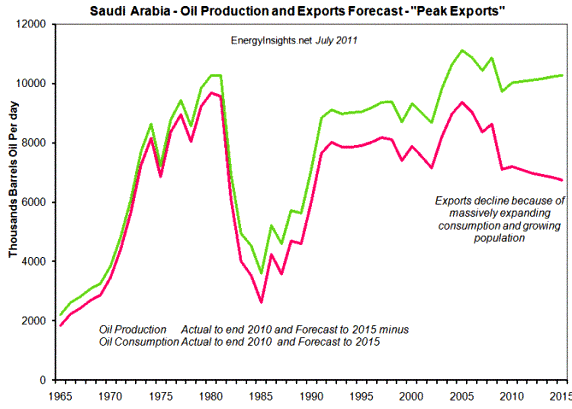443: Signal for the next oil crisis - investor update
08-31-2012
PropertyInvesting.net team
Peak Oil: As we have been advising for years now, Peak Oil (crude oil) was 2005 conventional crude oil production has not risen since then production has stayed around 75 million bbs/day since then. Overall oil production had a peak in July 2008 then another peak in January 2011 overall liquids production has slowly risen. But the only reason why total liquids have risen is because of significant increases in:
· Natural gas liquids (associated oil from the production of gas)
· Heavy oil
· Biofuel ethanol (from conversion of sugar cane and corn)
Stripping out the above, overall production of light sweet conventional crude has declined since 2005. Its worth noting that heavy oil takes a lot of energy and water to extract, whilst ethanol uses food to produce energy and is remarkably inefficient. Natural gas liquids have less value than normal light sweet crude oil and cannot be used for diesel or gasoline production. These three are lower end products signs that the world is becoming desperate for liquid hydrocarbons. Even with these new types of liquids added in, there is still not enough oil to suppress prices and despite recessions in many developed nations, oil prices still stay above $80/bbl.
What is Peak Oil?
This is when the production rate of oil peaks prior to going in to decline. It does not refer to oil reserves in the ground, only the rate at which oil is produced. So you can have increasing reserves but if oil production is declining, then Peak Oil is behind you. So the hard to extract heavy oil with lower production rate s will take longer to produce and hence once the light high rate oils have been extracted, its difficult to keep rates high to prevent a production decline. A big debating point is whether one should add in natural gas liquids, ethanol, gas-to-liquids (synthetic crude), and heavy oil. Stripping these out, oil production has peaked already. Adding them in, oil production has drifted slightly higher in the last 7 years struggling to keep pace with demand.
s will take longer to produce and hence once the light high rate oils have been extracted, its difficult to keep rates high to prevent a production decline. A big debating point is whether one should add in natural gas liquids, ethanol, gas-to-liquids (synthetic crude), and heavy oil. Stripping these out, oil production has peaked already. Adding them in, oil production has drifted slightly higher in the last 7 years struggling to keep pace with demand.
So how does this peaking of oil impact the global economy what is the significance?
Firstly, the days of cheap oil are well and truly over. The cost of extracting convention crude is now about $40/bbl and the cost of extracting unconventional crude (heavy oil) is about $80/bbl. Deepwater oil finding and producing costs are in the $40-80 range. Arctic oil is likely to be even more costly than $80/bbl if its ever extracted. So any decline of oil below $80/bbl for any significant period will see prices rebound again as production is shut-in or developments are cancelled. There are a few areas where the cost of producing is more like $10/bbl like Saudi Arabia, Kuwait and UAE, but to balance their books, they need oil prices over $90/bbl so its difficult to see that they would allow the oil price to drop much below $80/bbl moving forwards. The new price norm seems to be at least $80/bbl with think this floor will stay henceforth.

Is it just the low supply levels that are causing prices to rise?
Not at all. There are a number of factors. Firstly, a huge increase in demand from China, India and emerging nations in the last ten years has more than offset declines or stagnant demand in developed nations like USA, Germany, UK, Korea and Japan. The global supply has not managed to keep pace with demand from developing nations, hence prices have risen to cause demand destruction mainly in developed nations. Good examples of where high oil prices have hit economies are Greece, Italy, Spain, Portugal and Ireland all these countries tipped into severe debt when oil price skyrocketed to $147/bbl in mid-2008 and they never recovered. They are feeling the effects of Peak Oil.
Also, the US Feds policy of printing money has led to expectations of hig her inflation investors then use oil as a hedge against inflation because it is a physical asset. The Fed has driven interest rates close to zero meaning cash is used to speculate in risky physical assets like oil in attempts to make a return on cash. This has tended to support oil prices investor can see supply constraints and use purchase of physical oil futures-contracts as a hedged against inflation and in search of returns.
her inflation investors then use oil as a hedge against inflation because it is a physical asset. The Fed has driven interest rates close to zero meaning cash is used to speculate in risky physical assets like oil in attempts to make a return on cash. This has tended to support oil prices investor can see supply constraints and use purchase of physical oil futures-contracts as a hedged against inflation and in search of returns.
The dollar debasement also means that since oil is traded in dollars, OPEC countries want, require or demand more dollars for their physical oil barrels to compensate for the debasement this drives oil prices higher because OPEC put a squeeze on supply to edge oil prices higher. There is less incentive to invest in increasing capacity because over capacity will drive prices down.
The security issues in the Middle East also support prices because oil production declines in some of the nations affected examples include Syria, Libya, Egypt, South Sudan and Yemen to name but a few. Furthermore sanctions against Iran have taken a further 1 million bbls/day off the market (1.3% of global production) which has supported prices. The expectation of conflict also tends to drive prices higher and this is seen with the tensions between Iran, Israel and the USA. Add to this continuing production problems in countries like Nigeria and Venezuela and you can see major stresses in the oil production supply chain of the global economy.
H owever, do not underestimate the impact that the money printing has had if you increase money supply tenfold, expect to see ten times higher oil prices. This is what has happened since 1990 when oil prices were around $12/bbl now they are more like $120/bbl with debt levels are ten times higher. One should not pin all the blame on the suppliers of oil and security concerns the Fed has done more than most to boost oil prices with their money printing. But they and the US Administration working in concert are the last to acknowledge this.
owever, do not underestimate the impact that the money printing has had if you increase money supply tenfold, expect to see ten times higher oil prices. This is what has happened since 1990 when oil prices were around $12/bbl now they are more like $120/bbl with debt levels are ten times higher. One should not pin all the blame on the suppliers of oil and security concerns the Fed has done more than most to boost oil prices with their money printing. But they and the US Administration working in concert are the last to acknowledge this.
What is the outlook for oil prices?
They will continue to be very volatile. The floor for prices is probably about $70/bbl but any price over $125/bbl will lead to recessions in western developed nations that use over half of oil consumption. Recession would then cause demand destruction and prices would then drop back again. This has been happening for the last 7 years and looks set to continue we are bumping along a Peak Oil plateau as we have been describing for the last five years. China and other rapidly expanding nations are sucking new oil production into their developments and the rest the developed western world needs to cut back on consumption because of this. There is not enough cheap oil to go around. This situation will not change any time soon. As oil consumption in developed nations drops the countrys GDP will also drop the economy will stagnate. No net growth. This is the outlook for Europe and USA moving forwards these countries or regions will be lucky to grow at 1% per annum, and more likely to decline by 1% per annum. Remember the GDP numbers are manipulated because real inflation is far higher than governments claim so if the country claims a 1% GDP growth, and inflation is 2% higher than claimed, then real inflation adjusted GDP would be a recession of -1% GDP. This is what is happening in the UK, France, Italy and USA the countries are in mild recession its just the political establishment are not telling anyone the real story.
Is there any good new out there?
Yes. In the USA there has been huge advances in gas production along with some progress in oil  production from fraccing of horizontal wells in shale gas and oil shale deposits onshore. The Bakken, Marcellous and Eagle Ford Formations or Plays are key examples. Gas production has risen sharply in the last 5 years, US oil production has remarkably reversed its decline and the USA now has plentiful cheap gas at $2/mmbtu this is six times lower than the peak $12/mmbtu price of 2007. It is also six times cheaper than oil per calorific unit. But the big issue is getting people to convert to use this cheap natural gas to make a real difference it would need cars and trucks to convert on a grand scale. Uptake on low cost natural gas so far has been minimal. Though power companies have been fairly quick to convert.
production from fraccing of horizontal wells in shale gas and oil shale deposits onshore. The Bakken, Marcellous and Eagle Ford Formations or Plays are key examples. Gas production has risen sharply in the last 5 years, US oil production has remarkably reversed its decline and the USA now has plentiful cheap gas at $2/mmbtu this is six times lower than the peak $12/mmbtu price of 2007. It is also six times cheaper than oil per calorific unit. But the big issue is getting people to convert to use this cheap natural gas to make a real difference it would need cars and trucks to convert on a grand scale. Uptake on low cost natural gas so far has been minimal. Though power companies have been fairly quick to convert.
Elsewhere in the world, Argentina and China likely have large shale gas deposits although these are not yet confirmed. So far, the most promising shale gas in Europe has been a huge disappointment in Poland though its still fairly early days (low flow rates, too much nitrogen, non-economic).
The UK stalled out fraccing near Blackpool about a year ago after a few minor tremors no bigger than those cause by a passing lorry caused uproar locally. A well is shortly to be drilled in this area likely eventually to be fracced this will be the UKs first test and could transform the gas sector in the UK if it works in a similar way to the US gas sector.
How do I invest in Peak Oil?
When oil shortages occur, some industries tend to do better than others so as the ravages of Peak Oil worsen, shrewd investors show be:
Long
· Growing small to medium sized oil exploration and production companies stocks
· Oil ETFs
· Purchase of physical oil or oil contracts
· Property in safe oil exporting nations major rich cities with oil revenues
· Oil services company stocks
· Physical gold and silver (as a hedge against inflation and economic turmoil caused by Peak Oil)
Short
· Airline industry
· Tourism
· Retail in developed nations with high oil imports
· Power utility companies
· Property in far flung tourist destinations and countries with large oil imports compared to GDP
USA: For the US investors, there are many good US oil shale and shale gas companies that can be invested in. Also, real estate in Houston, Dallas-Irving-Fort Worth and North Dakota should perform well as the oil boom continues in these areas.
UK: In the UK, oil wealth heads towards West London prime real estate (from Russia, the Middle East and Africa). Oil is traded in London and many mining and oil companies have headquarters in London. Aberdeen is the technical centre of the oil business in Western Europe and is now a centre for global oil engineering property prices should continue to rise in Aberdeen since very little building is taking place and the aging oil population gets more wealthy from oil employment and retires in this area.
oil engineering property prices should continue to rise in Aberdeen since very little building is taking place and the aging oil population gets more wealthy from oil employment and retires in this area.
Russia: In Russia, St Petersburg and Moscow are the two cities that have huge wealth centred around the oil and gas industries this drives the Russian economy and is set to continue with massive oil and gas exports to Europe and China about 6 million barrels a day of oil exports, with the same in equivalent terms in gas during the winter months.
Norway: has gigantic oil and gas wealth per head of population so Olso, Bergen and Stavanger are winners they will continue to get even more wealthy as oil prices rise and gas exports remain at high levels. The Norway Sovereign Wealth Fund is about the most successful country wealth fund in the world no hint of recession in Norway. A continued safe prosperous future is the outlook. The transparency of government, business ethics and security are all very high.
Australia: is another country with huge mining reserves and massive gas resources wit h a large land mass and small population. Property prices have boomed, arguably a bubble and in our view hence its not a good time to invest in property in Australia simply because prices have doubled in the last five years. The country is also heavily exposed to a downturn in China. But long term, Australia has excellent fundamentals with well educated population and fairly good economic policies. A very stable country.
h a large land mass and small population. Property prices have boomed, arguably a bubble and in our view hence its not a good time to invest in property in Australia simply because prices have doubled in the last five years. The country is also heavily exposed to a downturn in China. But long term, Australia has excellent fundamentals with well educated population and fairly good economic policies. A very stable country.
Canada: is a real safe haven. It has gigantic reserves of heavy oil which become economic at prices over $80/bbl. The land mass is gigantic with a fairly small population. Mining is important and the population is well educated with security and safety high. Canada will do very well long term supplying resources to China and the USA its finances are strong. A winner along with Norway. Property prices have risen strongly in recent years, so its not without its risks but long term, Canada has to be one of the most robust economies in the world. It is exposed to a severe downturn of its larger neighbour the USA, but can probably survive fairly well on its own with its resources-export driven economy. If a US and Chinese recession hit and oil prices crashed to $50/bbl with commodities crashing, this would severely impact Canadas economy, but the chance of this happening is very small overall. Oil prices look unlikely to drop below $75/bbl with a large upside if the USA keeps printing money.
Middle East: The conventional view of Peak Oil is that the Middle East would do very well out of it because oil prices would rise. But this masks some key issues. As oil prices rise, then oil rich exporting Middle East nations have higher revenues the elite take some of the proceeds and pass other down t hrough higher social spending and subsidies to keep the masses happy. This is unsustainable in the long run because these countries have rapidly expanding populations living in extreme desert conditions requiring huge quantities of energy to keep cool. So as the population rises, their own oil demand rises, oil subsidies are endemic and exports eventually decline. Revenues then drop and as the population continues to expand, the deficits rise and social spending needs to drop then political and social turmoil break out. The masses revolt and turmoil sets in. This has so far happened in Egypt, Tunisia, Syria and Yemen all countries that have peaked in oil production. The countries that have not peaked ye Kuwait, UAE, Qatar, Saudi Arabia and Algeria have managed to hold it together so far. Iran remains unstable as oil exports drop through sanctions and the population continues to rise. In future years, as water resources become even more strained and food more expensive more riots and turmoil is likely in the Middle East as the realisation that millions of people living in the middle of extreme deserts simply is unsustainable without cheap oil. Sadly its an accident waiting to happen with populations doubling every twenty years and oil production in plateau or decline with exports in rapid decline. As more turmoil spreads this will likely make oil prices even more turbulent.
hrough higher social spending and subsidies to keep the masses happy. This is unsustainable in the long run because these countries have rapidly expanding populations living in extreme desert conditions requiring huge quantities of energy to keep cool. So as the population rises, their own oil demand rises, oil subsidies are endemic and exports eventually decline. Revenues then drop and as the population continues to expand, the deficits rise and social spending needs to drop then political and social turmoil break out. The masses revolt and turmoil sets in. This has so far happened in Egypt, Tunisia, Syria and Yemen all countries that have peaked in oil production. The countries that have not peaked ye Kuwait, UAE, Qatar, Saudi Arabia and Algeria have managed to hold it together so far. Iran remains unstable as oil exports drop through sanctions and the population continues to rise. In future years, as water resources become even more strained and food more expensive more riots and turmoil is likely in the Middle East as the realisation that millions of people living in the middle of extreme deserts simply is unsustainable without cheap oil. Sadly its an accident waiting to happen with populations doubling every twenty years and oil production in plateau or decline with exports in rapid decline. As more turmoil spreads this will likely make oil prices even more turbulent.

We hope this special report has improved your understanding of Peak Oil and given you insights into the direction the global economy is heading.

